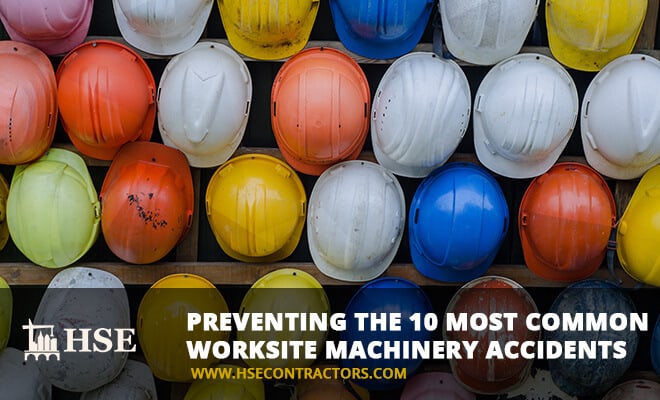Request A Quote For Our Scheduling Services
Thousands of hard-working Americans are injured annually in worksite accidents related to the operation of equipment and machinery. In addition, hundreds of workers are killed in accidents associated with equipment and machinery.
The Occupational Safety and Health Administration reports that nearly all of this equipment and machine accidents are avoidable. OSHA has developed specific strategies that are designed to prevent the 10 most commonplace worksite equipment and machinery accidents.
Overview of the Most Common Worksite Machinery Accidents
OSHA has identified the following equipment and machine accidents as being the most common in the United States:
- Getting on and off equipment or machines
- Loading and unloading equipment or machines
- Crowded work area
- Equipment and machine swing radius
- Operation of equipment or machines on a slope
- Buried or overhead obstructions
- Equipment or machine backing
- Equipment or machine upset
- Instability or load loss
- Log out – tag out
#1. Getting On and Off Equipment or Machines
According to data maintained by OSHA, the most common cause of worksite injuries associated with equipment and machines is getting on and off of equipment and machines. A key to ensuring safety getting on and off equipment and machines is to check boots and gloves. A worker needs to make certain these items are clean and in good repair or condition.
A person should always lower his or her self from a piece of equipment or machinery. A worker should never jump from a piece of equipment or machinery.
#2. Loading or Unloading Equipment or Machines
If a piece of equipment of machine requires loading or unloading, the potential can exist hat a roll-over or a similar mishap might occur. This potentiality exists even when equipment or a machine is on a flat surface (as it should be).
Protecting against injury in this type of scenario is to make sure a spotter is on hand. Enough free space must be available around a piece of equipment or a machine to ensure the ability for quick egress from it should instability or some other issue of that nature occurs.
#3. Crowded Work Area
Another major cause of accidents at worksites involving equipment or machinery is a people crowded into a work area. Oftentimes, personnel not required for the operation of equipment or a machine crowd around the work area “to see what is going on.” A worksite foreperson should always make it clear that crowding into a work area in this manner is not acceptable.
#4. Equipment and Machine Swing Radius
Swing radius accidents are commonplace at jobsites. In basic terms, these are accidents that occur when a person is injured being struck by a component of equipment or a machine during its normal course of operation. This type of accident can be avoided by roping off or otherwise securing the swing area associated with a particular piece of equipment or machine.
#5. Operation of Equipment or Machines on a Slope
When at all possible, equipment and machines should be operated on level surfaces. This is not always possible, however. Thus, when equipment or a machine must be operated on a slope, safety dictates that all safety precautions are implemented associated with this type of operation. A worker must know the limits of particular equipment or machines and must be aware of surface conditions.
#6. Buried or Overhead Obstructions
Exposure to buried or overhead obstructions cause a considerable number of worksite equipment or machinery accidents each year. The most important course to take to protect against these types of injuries is to clearly mark underground and overhead hazards.
#7. Equipment or Machine Backing
Yet another type of equipment or machinery accident that results in serious injuries each year involves equipment or machines in reverse motion. A variety of safety tactics need to be employed to protect against backing injuries. These include blocking off the perimeter where equipment or a machine is in use, the use of backup alarms and wide-angle mirrors, and use of rear-mounted backup sensors on equipment or machines.
#8. Equipment or Machine Upset
Equipment and machine upsets happen for a wide array of reasons. In most cases, a worker’s seatbelt or safety belt becomes his or her lifeline.
The sad reality is that time and again, a worker fails to use the seat or safety belt. As a result, an unnecessary number of workers are injured or killed due to an equipment or machine upset.
#9. Instability or Load Loss
Equipment and machines designed to more loads are the instruments of many worksite injuries and death each year. The fact is that improperly placed or packed loads can result in instability and even load loss.
Instability and load loss accidents and injuries can be avoided if a load properly is packed onto equipment or a machine in the first instance. In addition, a load should be provided a wide berth to protect third parties from instability or load loss related injuries.
#10. Log-Out – Tag-Out
Finally, workers of different types end up injured each year when a particular piece of equipment or a machine when proper lock-out – tag-out protocols are not followed. These protocols mean that everything from moving parts are locked or in a set position to ensuring that any associated load is in a secure position to a myriad of other stand-down issues in between.
According to OSHA, following this safety practices would not only reduce worksite equipment and machine accidents, but potentially could eliminate most of them all together. Following these practices can vastly improve the overall safety a workplace that relies on equipment and machines.
If you are interested in creating an optimized construction schedule or speaking with one of our construction scheduling engineers
Contact Us

